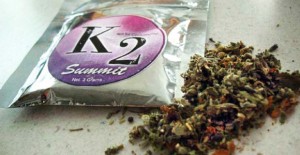Belville, Russ. “Synthetic Marijuana Epidemic Can Only Be Cured By Legalizing the Real Thing” Marijuanapolitics.com. Marijuana Politics. 10 Aug. 2015. Web. 12 Aug. 2015.
Russ Belville’s article “Synthetic Marijuana Epidemic Can Only Be Cured By Legalizing the Real Thing” discusses the recent rise in synthetic marijuana and why it had become popular. A large chunk of Belville’s article is spent discussing the various cases that have happened in recent years and how synthetic marijuana became the popular drug that it is. This is done by the author to argue that the only thing that can stop the spread of marijuana as shown by the title.
The article explains several examples of the effects of synthetic marijuana such as NYPD Commissioner Bill Brantton calling it a “weaponized marijuana.” Furthermore, he describes how a man in Washington DC was arrested for a robbery and fatal stabbing; the man was said to have had that mentality due to synthetic marijuana. He then moves on to explain why and how people buy the man made drug. He explains that the false aura of legal status surrounding synthetic is why people purchase it. He then follows up with saying that although cities have started to make the drug illegal it is very difficult to do so. He states, “as soon as officials define one particular synthetic cannabinoid as illegal, Chinese chemist just the molecular structure until it no longer matches the illegal definition.”
Belville uses to manipulate the audience into supporting his claim that the only answer to the synthetic marijuana epidemic is legalizing natural. He does this by pointing out the negative effects that synthetic marijuana has and how they have lead to many problems. While I agree with the problems that Belville states, he blinds himself with his own evidence. One example would be how he talks about the problem in Washington DC. This in turn is detrimental since marijuana is legal in the capital city. If legalizing the real thing is the answer and Washington DC have already done how come they are a part of the experiment. Belville defeats himself, he sets up all this evidence to make this big claim yet his own evidence contradicts his own statement. The authors own internal problems is something that could detract from a reader believing his claim.
Another thing that Belville brings up before his argument is this analogy, “Only marijuana prohibition could lead people seeking a natural high…like spike…just as only alcohol prohibition could’ve led to people seeking a buzz to drink denatured methanol.” While at face value the analogy seems true enough there are actually two different ideas. The rise of synthetic marijuana did stem from prohibition of natural marijuana but it is different than alcohol. Prohibition of alcohol was made illegal in the 1920’s but many still continue to drink because they liked drinking. In this part Belville links an article stating that the government poison some of the illegal liquor from being consumed. This is where the two cases differ, synthetic came in as solution to the weed problem but in reality has nothing to do with natural marijuana. On the other hand, the alcohol was still the same thing, alcohol. It wasn’t some man-made product that had no correlation to what people wanted. The author here is trying to compare peaches and bananas just because they were both in the fruit salad.
The most detrimental part of Belvilles argument that is flaw is his diction. The moment that he uses the word “only” he immediately shuts off the possibility of synthetic marijuana having many problems at the root or he is saying that just cutting one root will kill the tree. This certain by definition excludes other problems that come with synthetic marijuana. Synthetic marijuana is cheaper, as the author himself notes, but doesn’t dive into how this is a factor as to why people solve. People who wouldn’t be able to afford the real thing would instead settle for synthetic because of them wanting to seek that high. Furthermore, he makes no mention of the fact of another synthetic buyer, teens. Teens have also been affected by the rise of synthetic and if weed were legal teens wouldn’t be able to buy. Belville is so buying trying to convince the audience that natural marijuana should be legalized that he paints it as the solution to a problem that has multiple roots.





